Vex, Averse Sefira, Ayasoltec, Dagon, Abythos and Nodens
January 27, 2007
Redrum
Austin, Texas
Extreme Texas Metal presents a number of shows adapted for the new millennial audience. As is demanded by those who own clubs, these shows address the problem of too much music and too few willing to buy by lumping together related bands into a longer show, hoping to create a sense of similarity in a genre and to help each band market itself through exposure, much as bands now market themselves with MP3s. In addition, as black metal and death metal have both ceased growth and are now in a time of middle age maintenance, set upon by tedious hybrids like metalcore (emo) and nu-metal (hip-hop), these allow the genre to circle its wagons and retain whatever of its own identity it can preserve. Unlike most promoters, Extreme Texas Metal have been mostly successful in picking acts which share aesthetic similarities enough to provide a contiguous show.
In this naturalistic view of music, the local favorites are grouped together and given a chance, after which we all see who rises and who falls. Names and faces from the past have come and gone, with some remaining, according to an order that previous generations would have seen as the will of heaven and in pagan years before that, as the judgment of nature. The show began on an interesting note with death metal band Nodens, who came from Houston to play to about thirty people. Their music resembles the mid-paced death of former years as updated with a simple form of the harmonic churning popularized by Burzum and other black metal bands, but it retains much of the punch and drop from rising drive to collapsing breakdown that makes death metal popular to this day. While it is clear that Nodens are still developing, there is promise here should they choose to develop it, although at this time the effect is somewhat underwhelming owing to a prevalence of simple patterns designed more to carry a crowd that express what the more esoteric and ambiguous portions of their music offer.
Ayasoltec
After presentations by Abythos, who emit a black metal mixture approximating the mean of Dissection and Darkthrone, and Dagon, Watain-inspired melodic black metal battery, the show took on a different aura when Ayasoltec took the stage. This band rose from the ashes of longtime Texas legends Masochism, who united a sense of Chicano identity with the insurgent desire for localization of early-1990s death metal like Cenotaph or Sepultura, creating a unique voice that never came fully together through lineup changes and the confusion of identity that plagued death metal after black metal arrived. With Ayasoltec, the musicians responsible have clearly targetted a new direction but are still feeling out how to develop it. Their desire is to evoke the second culture of the Americas, who integrated an ancient race of explorers (probably those who created also Easter Island and the cities of pre-Incan Peru) with the Amerinds who arrived later from Asia. These ancient cultures, as seen in Toltec and Olmec and Aztec, produced works of vast culture that are recently being discovered more in depth throughout the Yucatan and Central Mexico, and unlike the Catholics to follow were sun-worshippers who adored the idea of blood sacrifice as much as they relentlessly invented nurturing societies and high culture. One of the most revolutionary statements a band can make today is to bypass modern American culture as well as modern Mexican to exhalt these ancestors of amoral, occult religion and culture.
Ayasoltec balance this concept unevenly between wanting to find an outlet for their death metal riffcraft and exploring those genres which might unite a group of people behind an idea superior to anything else offered as relevant to them today. In this, their obvious guidepost is Sepultura’s work from “Arise” through “Roots,” which integrated indigenous rhythms and themes with the tumescent power of death metal. Their material as such is balanced between rhythm riffing which is often single-string playing, like a hybrid between “Roots” and early Vader, and the adroit riffcraft of Masochism, as well as new style based upon fast harmonic motion that would be called “solos” except for its rotating sequence of pattern choices that make a growing melody out of what would otherwise be a series of riffs. Like Gorguts attempted with “Obscura,” this new effort uses less conventional guitar techniques and a tendency toward abundant noise and develops songs around conventional riffing mated with exploratory work, as if bringing us out and then inside an esoteric mystery.
It is quite promising for a band to develop this much imagic and musical specificity, but this is balanced by the growing pains of fusing death metal with the more rock-oriented rhythmic format that Sepultura adopted in their later work (as did other bands; Sepultura is the most convenient example). Songs incorporate doomy riffs, the aforementioned riff cryptograms of periodistic development, and the acerbic ripping death metal in the style of Imprecation or Massacra that distinguished Masochism. The audience was fortunate to hear a good deal of this before one of Ayasoltec’s amplifiers decided it desired the hatred of the 150 people gathered there, and began intermittent failures through which the band and lead guitarist Juan Torres played with aplomb until it was obvious that catastrophic equipment failure ended the show. It was a highly professional performance and all attending channeled ire at that amplifier and hate it to this day.
Averse Sefira
After Ayasoltec, the undernoticed but unflagging Texas metal legends Averse Sefira took the stage with no fuss but much anticipation as the crowd swelled. The concept behind Averse Sefira is esoteric as that of Ayasoltec, in that they unite the stages of spiritual development between earthbound and celestial through the mysteris of Kabbalah, an ancient Sumerian science later appropriated by Judaism and Christianity in less of an amoral, blood worshipping form. Through this voice Averse Sefira channel abundant pagan nature worship and cosmology, as well as a healthy dose of modern heroic transcendental holistic idealism, using a synthesis of melodic black metal and the savage energy that early technical death metal bands like Morbid Angel and Incantation held high like a banner of war. As drummer The Carcass was playing on an unfamiliar, triggered drumkit loaned graciously by Ayasoltec personnel, it took Averse Sefira a song to reach a balance of intensity while adapting to the new rhythm format, but after this a set of songs from their past two albums seared the ears of the audience. In this, they showcased their most aggressive and imaginative attack to date, “Tetragrammatical Astygmata,” with standouts from the sleeper hit “Battle’s Clarion” that never got the distribution or production it needed to become as legendary as it is in live presentation.
The Averse Sefira attack is well-honed not only from touring practice, which the band have gotten on jaunts to South America, Quebec, and Europe, but also from a study of successful extreme metal during the past twenty years. Like the most vital years of Deicide and Morbid Angel, they are short on pauses and small talk but launch immediately into each song with a one-line introduction adapted from the style of Slayer’s Tom Araya but with more lyrical relevance and grace. Their songs use a thematic flow of melodic riffs balanced against interludes of pure rhythm in the form of “budget riffs” that assemble a few notes into direction changes or augmentations, and build a rhythmic attack as they cycle periodistically but not linearly through a developing motif. Guitarist Sanguine A. Nocturne slashes out riffs in his precise tremelo playing while growling and whispering and screaming in a range of timbres in a style that must have been influenced by Burzum, yet in live performances balances the adroit precision of this playing with a small amount of swing that kicks in a demonstrative gesture of attack and release. Noisier adaptations of past riffs are deliberate, not accidental, and contribute to both the organic feel and the edginess of this performance.
The Carcass adapted well to the new drumkit after some experimentation, and was able to shape his organic battery around the highly audible exactitude of triggered drums, producing a sound that was more militant than previous Averse Sefira shows. The third member of this cosmological wrecking party, Wrath S. Diabolus, wielded his base with what seemed to more than one observer a greater degree of comfort and familiarity, showcasing a newly flexible style that complements the improvisatory chaos of his stringed counterpart. The band played six sounds with the presence that has made them legendary, standing defiantly in front of the crowd and delivering a top-notch show, while maintaining the mystery that has made this band a favorite of underground observers since their 1996 demo (and it is only fair to note that all members were in artistic projects for nearly a decade before that). It is hard to see why this band has not been acknowledged as the successors to Absu and Necrovore as the vanguard of Texas metal, but it is in part their quiet professionalism and musical and conceptual depth that makes them alienated from much of the scene which would prefer easily digestible music. No sonorous Twinkies here.
Vex
Coming out on stage after a brief equipment shuffle, Extreme Texas Metal band of the year Vex both impressed and disappointed. When one thinks about it, bad record reviews for competent musicians all take the same form: the elements were good but did not fit together into something that made sense or communicated an intent, so becoming like quality wallpaper an interesting accessory but not the experience of transcendental rediscovery of life that truly powerful art provides. Vex has become a similar story: their style ranges from At the Gates to Gorguts, but their songs are more a collection of riffs bent around a verse-chorus structure than a coherent whole or communication. Their new vocalist adopts poses and attitudes adopted most clearly from Pantera’s Phil Anselmo, sounding as out of place as a NAMBLA member at a Klan meeting, and the discoherence of overall songcraft allows each musician to masturbate profligately without enhancing the song. Guitarist Cioran seemed to contribute the subtler and more intelligent aspects, but the rest were jamming along to a tune known only to themselves, and the result sounded like a collision between Opeth and Cannibal Corpse trying to be a lounge act. Although many praise this band now, unless they gain enough discipline to pick a direction and have each individual make the sacrifice in glory necessary to make it work, they will become more of the detritus lining the long road back from failure, at least in the eyes of those fans who make their biggest contribution as a genre winds down by picking those who history (however brief) will remember.
The show as a whole was magnificent, in that few areas are fortunate enough to have this kind of force of organization making available the choices in art that we have here in Texas, and the promoters and club are to be praised for enforcing sensibility without making decisions the fans alone can make (or hopefully, the smart fans: a proliferation of the usual Austin crowd of dilettantes, hipsters, hangers-on, poseurs and assorted parasites were present but not overdominant, but we the thinkers would rather those idiots make no decisions for us). The night is best summed up by remembering the triumphs of Ayasoltec and Averse Sefira, the good initial effort from Nodens, and the speech made by Averse Sefira’s Wrath during the final soaring of their set, in which he drew a distinction between those who feel and believe in the music as a way of life and a mapping of philosophy that shows us a values system for living heroically, and those for whom it is only fashion. Time will tell that ultimate judgment, but for now, the power and determination of these bands suggests an intense future for Texas metal.
Bands:
Vex
Averse Sefira
Ayasoltec
Nodens
Promoters:
Extreme Texas Metal
Redrum (Austin, TX)
Another take:
Fall has ended; winter has arrived, and the die-off is upon us. Those who saw metal as a fun trend are hopping onto the next one, and, resultingly, there will be fewer and fewer bands aiming towards this crowd. With this dying of the bands, however, comes room for new entities, similar to how a pack of wolves picking off the sick and weak deer creates room for more deer to exist. This show seemed to reflect aspects of this transition; the percentage of bands worth seeing was perhaps the highest of any show this author has been to.
Nodens
Nodens plays relatively brutal death metal, but with some melodic enlightenment, with two guitarists playing deft riffs in counterpoint over the requisite blasting drums. Songs do a good job at shifting moods in a logical order, implying a coherent narrative, although the overuse of certain songwriting techniques (all instruments dropping out to create a climax while bringing in a new riff) robs them of their power, and each song seemed to lack a finale, a closing statement, a destination to the journey. Nodens is worth keeping an eye on, and worth witnessing live, but in their current form, they still need work to reach the upper eschelons of the genre.
Dagon
Watain for retards.
Abythos
Seemingly attempting to combine every sub-genre of metal known to man, Abythos is probably most comparable to the more tolerable parts of the post-“Slaughter of the Soul” Gothenburg sub-genre, in that it melds mostly traditional heavy metal riffing with distorted vocals and occasional blasting sections, with a few doom sections and undistorted intros thrown in for “good” measure. The problem is that in this mish-mash of ideas, no internal logic shines through, and thus the entire thing can only be interpreted as disconnected emotions, pure sacharrine, melodrama with no drama, which quickly becomes BORING. Musicianship is good, but who cares? Only reccomended for those trying to cure extreme insomnia.
Ayasoltec
It’s impossible to win when fighting against problems with gear, but Ayasoltec handled it as well as imaginably possible. On the border between avant-technical death metal and a distinctly Mexican take on Graveland’s “Thousand Swords”, Ayasoltec thrives on serpentine, arcane lead-riff work, with amazingly organic song progression crafted from the ability to manifest small changes in a melody to profound effect over time, and in the usage of discordant “solos” (quoted not as a method of slight or insult, but simply because it’s difficult in this case to determine what should be considered as a solo, and what should be considered more of the lead riffing, so complete is their integration) that flow in and out of the lead riffing amazingly well. The band also wins favor with this author by having a bassist who is not simply a stage prop, but who, while mostly following the melody of the guitar, brings in differently accented rhythms, giving a second angle on the music. Unfortunately, the appreciation of the music was somewhat dampened by factors beyond the band’s control; the guitarist’s amp had problems, causing the guitar to frequently drop out. The band handled this admirably, though, with the two remaining members continuing to play while the guitarist sorted out the issues as quickly as he could, and managed to get right back into where the band was without faltering, until the next drop out. A few rough edges exist musically- a few of the transitions are unduly sudden for music that largely depends so much on flow and gradual change- but, for those who would like to experience art that is truly mystical, art that conjures storms and spirits from beyond this world, Ayasoltec is strongly reccomended.
Averse Sefira
Judging by the number of people on the floor, Averse Sefira was the first of the bands who played that night who attracted Hessians to Austin. Facing difficult circumstances, with drummer The Carcass playing on triggered drums, a sensation completely unfamiliar with him, the band faltered at first, but quickly pulled together, in a particularly noisy and intense set pulled entirely from the band’s most recent album, “Tetragrammatical Astygmata”. Guitar and bass combined to form a musical haze of sound, creating something akin to a more poetically evocative version of Antaeus’s “CYFAWS”, intertwining energetic physical motivations with a zest towards the transcendent ideal, bestial fury with spiritual contemplation, in a manner such that the former of those pairs exists to work towards the realization the latter. Guitarist and vocalist Sanguine Mapsama provided the central element of the assault, with fast, dissonant lines inciting the flesh towards bloodlust and throat-damaging shrieks programming the audience by example of their complete inhumanity. Master percussionist The Carcass, who is apparently too demanding for ordinary mortal drum sets, created amazingly complex yet completely mesmerising rhythms, tastefully enhancing and embellishing the guitar’s rhythms, and directing the dynamics of the pieces. And finally, Wrath Sathariel Diabolus, the bassist of the trio, anchored the band’s sound, occasionally briefly playing with no accompaniment, as a forshadowing of renewed attack, and also greatly helped the band’s stage presence, being the most visually imposing and physically active member of the band. The crowd was appreciative, if not fully understanding, of what occured before them, and all were seemingly changed by the experience. Then again, who could remain un-touched after witnessing such a potent, if obscure, art? A special word must be given to Wrath’s short speech on the meaning of metal as a genre. War is raging between those who see metal as a genre communicating the transcendental and eternal, as a lifestyle striving for meaning in a plastic world, and those who see it as trivial social entertainment, and Wrath directed that which he is named for at the latter camp, to the appreciation of a surprising number of those in attendance.
When I make this sign, it means I stand for metal as an art form, and as a way of life. It has nothing to do with your stupid metal cartoons or your Spinal Tap movies. Think about what you mean when you make this sign. If it’s something you think is fun to do on the weekends, something that you think is funny, something that makes you smile, then FUCK OFF! We’re taking it back.
– Wrath of Averse Sefira
Approximate setlist:
Plagabraha
Decapitation of Sigils
Helix in Audience
Cremation of Ideologies
Hierophant Disgorging
Mana Anima
Detonation
Vex
A stark contrast to the previous band; rather than a statement of the esoteric, Vex seemed to be an embrace of the transient, fulfilling every metal cliche along the path to entertaining many yet making no definitive statement. If you can imagine a non-musical sign of a bad crowd-pleasing metal band, it was probably present here; from the tough-guy vocalist wearing a tank-top, to said vocalist jumping into the crowd to mosh, to one guitarist’s utterly insipid way of trying to sound “cool” while asking for water. Musically, “fragmented” barely begins to describe it; blasting death-metalish sections are followed quickly by random acoustic parts, followed by traditional metal breaks and doom passages, into outright stadium rock. What is sort of tragic about this, though, is that many of the individual pieces are quite good. Guitarist Ciaran obviously has a good ear for a melodic riff, and if the band would focus on these aspects of the music, without worrying about throwing in other elements to keep people of all tastes entertained, and give each song a clear concept to work towards, an overarching vision, it would be excellent. However, this doesn’t seem to be happening, and therefore this reviewer is unable to reccomend this band to others.Compared to the previous show seen at this venue, operations have improved vastly. The club was much more “under-21 friendly” (previously, they charged more for minors), and the bathroom, while still not pleasant, was improved. The venue continued its tradition of letting people to congregate on the outside porch between bands and during bands which they had no interest in seeing, an idea appreciated by this reviewer. Also, the crowd featured fewer attention whores and seemingly fewer hipsters than the previous show this author attended (probably by virtue of it not being marketed as a Halloween party), an appreciated improvement. The show ran smoothly, and the soundman seemed to know what was going on, and found a reasonable sound for each band.
– Written by Cynical
No Comments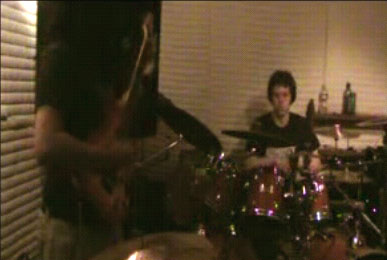
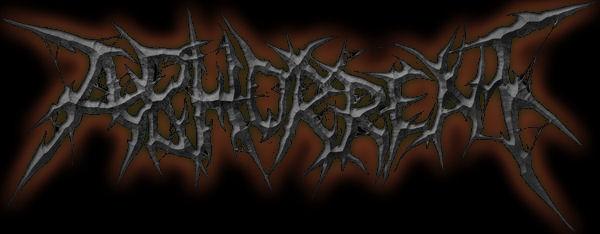
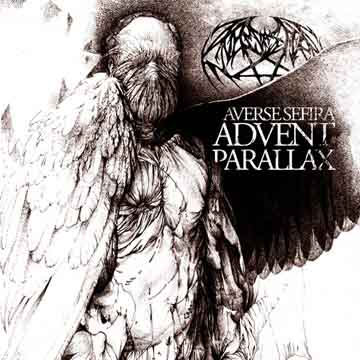
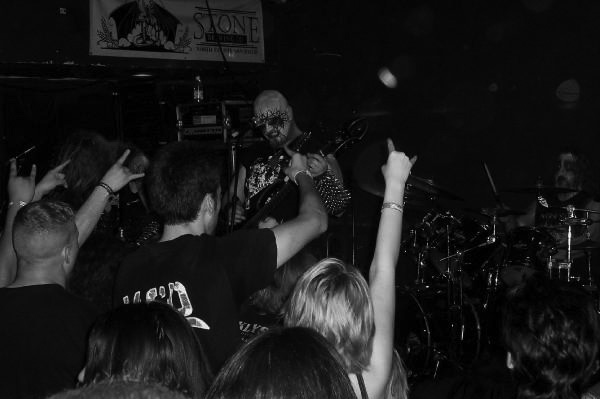
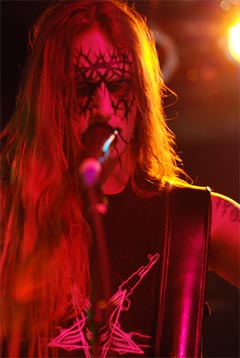 Few metal bands maintain their essential character for anything beyond the ephemeral. This tour package brought together four death/black metal bands who have been cultivating their respective crafts for at least a decade each: Averse Sefira almost exactly that, Rotting Christ and Immolation twice as long, and Belphegor somewhere in between, all with varying success in this regard. This longevity reflected well in the clarity of presentation, and also brought out many contrasts among these four acts.
Few metal bands maintain their essential character for anything beyond the ephemeral. This tour package brought together four death/black metal bands who have been cultivating their respective crafts for at least a decade each: Averse Sefira almost exactly that, Rotting Christ and Immolation twice as long, and Belphegor somewhere in between, all with varying success in this regard. This longevity reflected well in the clarity of presentation, and also brought out many contrasts among these four acts.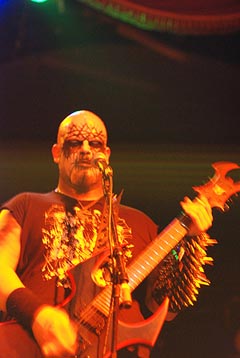 This mastery of the live setting brings up a crucial point about recent Immolation history. There is some sense of formula in their most recent recorded works, the seeking of trademark over creation. The falling back on “Immolation” themes seems in many cases, including in otherwise throughtful songs, a bane to their ability to match the beauty of their earliest material, something more akin to the needs of groups of captive observers than the lone listener, though they make it work very well as a result. Their manner is alternatively frenetic and menacing, and the visual accompaniment is enough to turn some otherwise absolutely flat passages into more sensible transitions when taken all together.
This mastery of the live setting brings up a crucial point about recent Immolation history. There is some sense of formula in their most recent recorded works, the seeking of trademark over creation. The falling back on “Immolation” themes seems in many cases, including in otherwise throughtful songs, a bane to their ability to match the beauty of their earliest material, something more akin to the needs of groups of captive observers than the lone listener, though they make it work very well as a result. Their manner is alternatively frenetic and menacing, and the visual accompaniment is enough to turn some otherwise absolutely flat passages into more sensible transitions when taken all together.
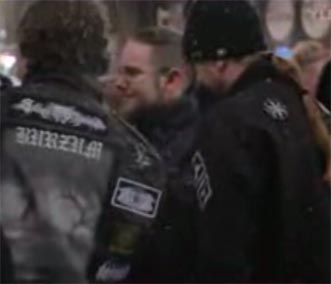
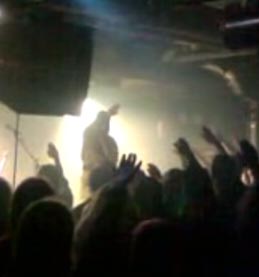 Seeing the infamous Absurd performing live was of course the thing most of us had been eagerly waiting for since the gig was first announced. Despite the original philosopher of the band being present behind the scenes, understandably the line-up was the new Absurd, with no common members with that which performed the classic albums “Facta Loquuntur” and “Asgardsrei”. Nevertheless, when Herr Wolf captured the stage after the “Leben ist Krieg…” intro and launched into the title track from “Asgardsrei”, there was little doubt that this new incarnation of the band is capable of evoking unique radicalness and danger as only Absurd could, from its inception. Ask the members of the audience who were at the receving end of the flying mic stand! Wolf’s close-cropped haircut and chest armor brought to mind a medieval warrior, Oi! provocator and Judas Priest at the same time. His absurd (how else?) stage mannerisms included bouncing to the beat, grinning at the audience, picking fights and talking in German. The songs they played included “Werwolf”, “Gates of Heaven”, “Pesttanz”, “Eternal Winter” and “Der Sieg ist Unser” from “Facta Loquuntur”, “Als die Alten jung noch waren” and “Für Germanien” in addition to the title track from “Asgardsrei” and an assortment of tracks from the later albums which I do not know well enough to name, but they all worked very well to these ears. It’s doubtful that the old lineup could have played the songs with this technical precision, but of course I do admit to a slight mourning in my soul at that the earlier, most cult, lineup disbanded.
Seeing the infamous Absurd performing live was of course the thing most of us had been eagerly waiting for since the gig was first announced. Despite the original philosopher of the band being present behind the scenes, understandably the line-up was the new Absurd, with no common members with that which performed the classic albums “Facta Loquuntur” and “Asgardsrei”. Nevertheless, when Herr Wolf captured the stage after the “Leben ist Krieg…” intro and launched into the title track from “Asgardsrei”, there was little doubt that this new incarnation of the band is capable of evoking unique radicalness and danger as only Absurd could, from its inception. Ask the members of the audience who were at the receving end of the flying mic stand! Wolf’s close-cropped haircut and chest armor brought to mind a medieval warrior, Oi! provocator and Judas Priest at the same time. His absurd (how else?) stage mannerisms included bouncing to the beat, grinning at the audience, picking fights and talking in German. The songs they played included “Werwolf”, “Gates of Heaven”, “Pesttanz”, “Eternal Winter” and “Der Sieg ist Unser” from “Facta Loquuntur”, “Als die Alten jung noch waren” and “Für Germanien” in addition to the title track from “Asgardsrei” and an assortment of tracks from the later albums which I do not know well enough to name, but they all worked very well to these ears. It’s doubtful that the old lineup could have played the songs with this technical precision, but of course I do admit to a slight mourning in my soul at that the earlier, most cult, lineup disbanded.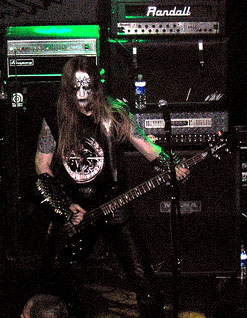 Confusion marked our entrance into the Knitting Factory, where it was being decided that bands would not play in the order originally listed. Making it more chaotic, they all played on the same stage, ensuring that hasty transfers of band would scatter personnel and equipment across the stage and inevitably result in some “who has the voice mike” satire. Despite this tower of live performance Babel, the bands involved bravely sallied forth with loins girded in guitar straps and gumption alone.
Confusion marked our entrance into the Knitting Factory, where it was being decided that bands would not play in the order originally listed. Making it more chaotic, they all played on the same stage, ensuring that hasty transfers of band would scatter personnel and equipment across the stage and inevitably result in some “who has the voice mike” satire. Despite this tower of live performance Babel, the bands involved bravely sallied forth with loins girded in guitar straps and gumption alone.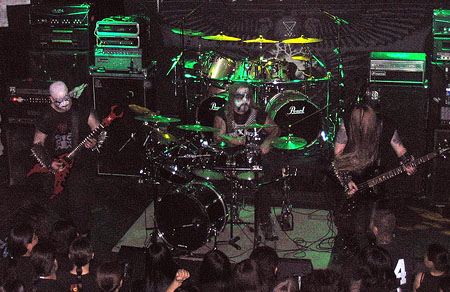
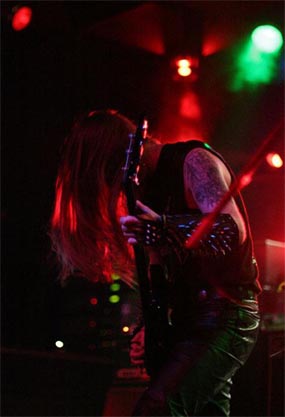 This show is one of those memories you forget is real, and find yourself a week later thinking how it occupies a space between thought and dream and a pinch-yourself moment in the midst of chaos. Arriving late after a harrowing evening involving taking a good friend to the hospital after he ate a rack of Xanax and downed half a bottle of Absolut, I was barely inside the door before a familiar guitar tone rose up into the soundcheck. Other people were hurrying toward the stage as well, and I found myself caught up in the anticipation.
This show is one of those memories you forget is real, and find yourself a week later thinking how it occupies a space between thought and dream and a pinch-yourself moment in the midst of chaos. Arriving late after a harrowing evening involving taking a good friend to the hospital after he ate a rack of Xanax and downed half a bottle of Absolut, I was barely inside the door before a familiar guitar tone rose up into the soundcheck. Other people were hurrying toward the stage as well, and I found myself caught up in the anticipation.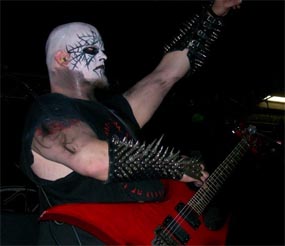 Their stage presence was typical Averse Sefira, but it cannot be taken for granted. None of the ingratiating, gregarious, vapid banter and skit-like dramatics lit up the stage, but a force of concentration, expressed less in the trivial acts than the commanding performance they gave. There was none of the mixed confused emotions that plague most bands on stage, where they’re half there as a job, half as a hobby, and unsure of whether to resent the audience of grovel before them. With Averse Sefira on the stage, the shared assumption that we were all of us there to see a performance to conclusion like a ritual united us, and we did not need reminders.
Their stage presence was typical Averse Sefira, but it cannot be taken for granted. None of the ingratiating, gregarious, vapid banter and skit-like dramatics lit up the stage, but a force of concentration, expressed less in the trivial acts than the commanding performance they gave. There was none of the mixed confused emotions that plague most bands on stage, where they’re half there as a job, half as a hobby, and unsure of whether to resent the audience of grovel before them. With Averse Sefira on the stage, the shared assumption that we were all of us there to see a performance to conclusion like a ritual united us, and we did not need reminders.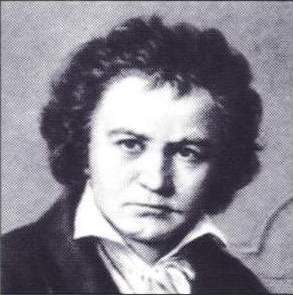 As the cultureless void of “pop culture” (more accurately known as “mass culture,” appealing to the lowest common denominator) surges upon those traditions of artistic development which have sustained high-quality minds for centuries, symphonies defend themselves by appealing to what they hope are broader audiences. In doing so, they achieve a fragile balance between the known commendables and newer or more esoteric pieces, more accurately known as being the fringes of classical music that did not merit induct into its archetype: history rewards either excellence or pure mediocrity.
As the cultureless void of “pop culture” (more accurately known as “mass culture,” appealing to the lowest common denominator) surges upon those traditions of artistic development which have sustained high-quality minds for centuries, symphonies defend themselves by appealing to what they hope are broader audiences. In doing so, they achieve a fragile balance between the known commendables and newer or more esoteric pieces, more accurately known as being the fringes of classical music that did not merit induct into its archetype: history rewards either excellence or pure mediocrity. Graf treats classic pieces as entities that while alive might benefit from upgrade to the wisdom of a progressive time, and in that state of mind he mixes a quaint style that appeals to fans of older Mozart and Haydn with a modernist twist that propels pieces forward with increasingly off-time, theatrical pauses and rhythmic expectations. It is as if Graf is a modernist who views the quaint as one of the many voices he tries to capture, and in doing so, he often loses sight of the piece as a whole, which is where he will remain a B+ and the Furtwanglers, von Karajans, Salonens, et al. will surge forward to the higher grades.
Graf treats classic pieces as entities that while alive might benefit from upgrade to the wisdom of a progressive time, and in that state of mind he mixes a quaint style that appeals to fans of older Mozart and Haydn with a modernist twist that propels pieces forward with increasingly off-time, theatrical pauses and rhythmic expectations. It is as if Graf is a modernist who views the quaint as one of the many voices he tries to capture, and in doing so, he often loses sight of the piece as a whole, which is where he will remain a B+ and the Furtwanglers, von Karajans, Salonens, et al. will surge forward to the higher grades. In the fourth movement Graf made a strong return, although like Klemperor he often prefers dramatic pauses to introduce obvious changes in theme, and complements them with a tendency to play repeated themes slowly like a movie soundtrack and elide them with rhythmic consistency and a lack of distinction for the subtleties that prepare us for their shifting. It is probably not a failing of intellectual ability on his part, but a desire to belong to the fashion that includes modernism and postmodernism, or the idea of subjecting all things to a mechanical process and controlling them through rules of self-interest which promote egoism and other out-of-context appearance of supporting structures. It can reduce complex music to a one-dimensional machine transferring energy between otherwise equal parts.
In the fourth movement Graf made a strong return, although like Klemperor he often prefers dramatic pauses to introduce obvious changes in theme, and complements them with a tendency to play repeated themes slowly like a movie soundtrack and elide them with rhythmic consistency and a lack of distinction for the subtleties that prepare us for their shifting. It is probably not a failing of intellectual ability on his part, but a desire to belong to the fashion that includes modernism and postmodernism, or the idea of subjecting all things to a mechanical process and controlling them through rules of self-interest which promote egoism and other out-of-context appearance of supporting structures. It can reduce complex music to a one-dimensional machine transferring energy between otherwise equal parts.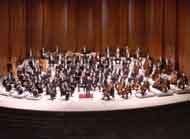 This image lingered in the mind for the long passage through the winding freeways of downtown Houston, through the parking lot where newsprint stained thumbs are licked to separate change for a twenty, and into the dark cavernous quiet of Jones Hall to hear Hans Graf conduct Anton Bruckner. Opening the piece with a chorus singing Bruckner’s “Ave Maria” from the lobby, Graf paused briefly and then raised his wand, to which a synchronized rising of instruments announced the descent from our world of tangible objects into the abstraction of music had become. The concert began from a silence in which the echoes of human voices still faded.
This image lingered in the mind for the long passage through the winding freeways of downtown Houston, through the parking lot where newsprint stained thumbs are licked to separate change for a twenty, and into the dark cavernous quiet of Jones Hall to hear Hans Graf conduct Anton Bruckner. Opening the piece with a chorus singing Bruckner’s “Ave Maria” from the lobby, Graf paused briefly and then raised his wand, to which a synchronized rising of instruments announced the descent from our world of tangible objects into the abstraction of music had become. The concert began from a silence in which the echoes of human voices still faded.
